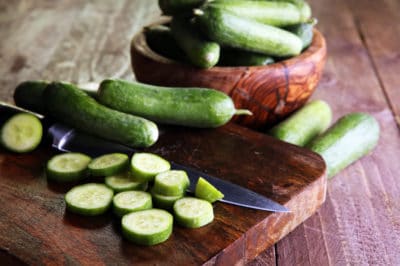What Makes Cucumbers Bitter
Along with squashes and melons, cucumbers belong to the Cucurbit family. As a defense mechanism against predators, all of them produce extremely bitter chemicals called cucurbitacins. In suitable growing conditions, these chemicals are limited to the plants’ stems and leaves. But when things go wrong, they may migrate to the fruit.
About Cucurbitacins
In normal growing conditions, cucurbitacins are limited to a cucumber’s skin and stem end. The amount a single fruit contains is low enough to be almost undetectable. But when things go wrong, the bitter taste migrates into the fruit itself. Three factors — watering, temperature and heredity — are connected to increased cucurbitacins.
Inconsistent Watering
Any cucumber that frequently goes from being excessively dry to excessively wet is stressed. It may respond to the stress by releasing more defensive cucurbitacins. This is especially true of cukes in the flowering and fruiting stages.
Well-hydrated cucumbers get between 1 and 2 inches of water each week, or between 6 and 12 gallons for every 1 square foot of soil. Cukes growing in sandy soil are likely to need the higher amount. The goal is to keep the soil moist to the touch at all times without saturating it.
Expert gardener’s tips:
- If possible, water your cucumbers once or twice weekly using a drip system or soaker hose. You’ll keep their leaves dry — and less likely to attract fungal disease.
- Maintaining a 2-inch layer of organic mulch such as straw or shredded leaves around your cukes retains soil moisture and discourages weeds.
Too Much Heat
Any cucumber loses its cool when temperatures settle above 90°F (32.2°C). Besides developing bitter fruit, overheated cukes start producing fewer female and more male flowers flowers. That translates to a smaller crop. To limit heat stress, provide your cukes with filtered afternoon shade.
Expert gardener’s tip: If your cuke patch lacks afternoon shade, compensate by draping them with a shade cloth available from your garden store. Look for one rated to block 50% of the sunlight.
Inherited Traits
Genetics also dictates whether cucumber vines produce bitter fruit. The ones with the dominant Bt-1 gene produce the most cucurbitacins, and have an extremely bitter taste. Cucumbers with recessive bi-1 gene, however, have no cucurbitacins. They’re not bitter even when severely stressed.
Expert gardener’s tip: In between extremely bitter and bitter-free cukes are the burpless varieties. While bred to have fewer cucurbitacins, they lack the bi-1 gene. Under stressful conditions, their fruit may be bitter.
Some Bitter-Free Cuke Cultivars
Count on these cuke cultivars to deliver sweet crops:
- ‘Diva.’ This self-pollinating, disease-resistant 6-foot vining cultivar produces heavy crops of 5- to 7-inch crunchy, sweet slicing cukes in 58 days.
- ‘Marketmore 80.’ Another disease-resistant choice with blocky,6-to 8 inch salad and slicing cukes. A good cool-weather performer, it’s ready to harvest in 61 to 68 days.
- ‘Sweet Success.’ Best grown on a trellis, this self-pollinating variety grows equally well in a greenhouse or garden. Notable for its smooth, thin-skinned 12- to 14-inch cukes, it resists leaf spot and mildew.
- ‘County Fair.’ A classic pickling cucumber with minimal seeds and mild, sweet easily digestible flesh. The fruit makes great spears, chips and whole pickles. Harvest in 48 to 53 days.
Salvaging Not-Too-Bitter Cukes
In mildly stressed cukes, the bitter taste is limited to the skin and stem end. To salvage them, slice a 1- to 2-inch piece from the stem end. Using a circular motion, rub the cut piece over the cuke’s open surface. A foamy white fluid will bubble up. Keep rubbing until the foaming subsides. If the flesh isn’t bitter, the cuke can be peeled and eaten.
